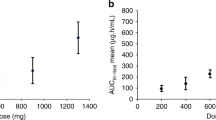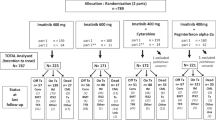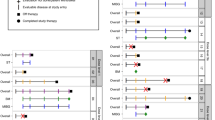Abstract
Since the publication of the results of phase I dose-finding studies, an extensive phase II and III clinical study programme has been undertaken to study the clinical efficacy and tolerability of the quinazoline folate analogue raltitrexed ('Tomudex'), a novel direct and specific inhibitor of thymidylate synthase. Two international phase III trials, studies 3 and 12, have compared raltitrexed 3 mg m(-2) with 5-fluorouracil (5-FU) plus low-dose leucovorin (LV) (Mayo regimen) or high-dose LV (Machover regimen) respectively. A North American study (study 10) was originally set up to compare two raltitrexed dosage arms (3.0 and 4.0 mg m[-2]) with 5-FU and low-dose LV, but the 4.0 mg m(-2) arm was discontinued prematurely because of excessive toxicity. Minimum follow-up times for studies 3, 10 and 12 were 15.5, 12 and 9 months, respectively (for data other than survival), with corresponding survival follow-up times of 26, 12 and 17 months. Objective response rates were similar for raltitrexed and 5-FU + LV, and palliative improvements were seen to a similar extent with both treatments in all phase III studies. Survival was statistically similar for raltitrexed and 5-FU + LV in both studies 3 and 12. Raltitrexed was, however, associated with inferior survival to 5-FU + low-dose LV in study 10, but there appears to be evidence that this was linked to an unconscious effect on investigator behaviour of early toxicity problems in this trial, in that patients appeared to be withdrawn from raltitrexed treatment without progression or protocolled toxicity. Moreover, it appeared that 5-FU + LV patients were continued on treatment after disease progression. 5-FU-based therapy was associated with a higher incidence of mucositis than raltitrexed in all studies, with the attainment of statistical significance in studies 3 and 12. Elevations in hepatic transaminase levels were seen with raltitrexed, but these are thought to be of no clinical significance. Overall, much greater levels of toxicity were seen with 5-FU + LV than with raltitrexed in early treatment cycles. In addition, retrospective UK audit data have shown the monthly cost of raltitrexed therapy to be similar to that of Mayo and continuous infusion 5-FU regimens, and appreciably lower than that of the de Gramont regimen of 5-FU (bolus + 22-h infusion) + high-dose LV. Thus, raltitrexed is an effective alternative to 5-FU-based therapy in patients with advanced colorectal cancer, with an acceptable and, unlike 5-FU, predictable toxicity profile. In particular, patients receiving raltitrexed may benefit from the minimization or avoidance of mucositis, and both patients and healthcare providers may find the convenient administration schedule of the drug advantageous.
This is a preview of subscription content, access via your institution
Access options
Subscribe to this journal
Receive 24 print issues and online access
$259.00 per year
only $10.79 per issue
Buy this article
- Purchase on Springer Link
- Instant access to full article PDF
Prices may be subject to local taxes which are calculated during checkout
Similar content being viewed by others
Author information
Authors and Affiliations
Rights and permissions
About this article
Cite this article
Cunningham, D. Mature results from three large controlled studies with raltitrexed ('Tomudex'). Br J Cancer 77 (Suppl 2), 15–21 (1998). https://doi.org/10.1038/bjc.1998.421
Issue Date:
DOI: https://doi.org/10.1038/bjc.1998.421



